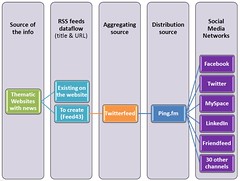Because it won’t work without you!
We’ve talked about strategy before, and quickly mentioned how important you as an individual are in your marketing strategy. At the risk of repeating myself, I’ll say again that beyond knowing your book and what’s unique about it better than anyone else. Your role in your own strategy is the key player, the mover and shaker—and yes, the marketer.
 What does that mean for your strategy? It means that you’re going to have to stick to things you know how to do or are willing to learn. It means that you need to focus on tactics and campaigns you enjoy, do well, can reach your audience through, and, yes, have the time for.
What does that mean for your strategy? It means that you’re going to have to stick to things you know how to do or are willing to learn. It means that you need to focus on tactics and campaigns you enjoy, do well, can reach your audience through, and, yes, have the time for.
Last time, I noted how important it is that you look at your past Internet habits as a clue to what kind of Internet marketing tactics might work well for you. But first, of course, you need your strategy to guide you.
You’ve already got your unique selling proposition statement and you already know how your book fits into the market—what it’s like and what it’s different from. You know why it appeals to your potential audience—and now it’s time to figure out how to apply strategic information to your tactics.
Moving from strategy to tactics
(Just in case you missed that the first time)
A lot of people out there will tell you that you must must MUST do X, Y, and Q7. But worrying about what someone who doesn’t know you or your audience thinks you “should” do—and forcing yourself to use tactics that crush your soul—is seldom a recipe for long term success.
In that vein, I’m not going to tell you that you have to use email, Facebook, Twitter, Goodreads, blogs or any other online or offline tactic. (Don’t forget about offline marketing!) Instead, we’re going to talk briefly about how to identify the tactics you want to use and how to figure out the best way for you to use them.
We’ve already mentioned using tactics that you’re comfortable with or willing to learn. Using that to narrow down your options is a good way to start. Let’s use Twitter as an example, and assume that you’re already comfortable with Twitter or have taken a little time to learn. (And yes, we’ll probably discuss Twitter as a tactic some time in the future on Marketing Mondays.)
The first thing you’ll want to do is observe. Watch how people use Twitter, both for marketing  purposes and for personal purposes. You’ll note that on Twitter—as on many other platforms (and in person)—constantly talking about yourself and your book is generally considered bad form, and it’s a turn off for many people.
purposes and for personal purposes. You’ll note that on Twitter—as on many other platforms (and in person)—constantly talking about yourself and your book is generally considered bad form, and it’s a turn off for many people.
You’ll also see how people form friendships and connections on the site, and hopefully jump in and form them as well, moving into a connect phase. With social media, it’s usually the personal connections that count the most—something I hope you’ll see if you observe  . These personal connections can be the most important part of your strategy. Look for people who are part of your audience, whom you would actually like to talk/Tweet to. Their Tweet streams look interesting, and they’re having conversations you’re interested in. You can also use site features like Lists (or groups on other sites) to look for people with similar interests, and watch how they converse with one another, then connect with them as well. Remember: we’re talking about building real connections, not just saying, “I’m going to target you because you are in my audience! Now I will address you as an audience but will never actually respond if you happen to acknowledge me! Prepare to be spammed!”
. These personal connections can be the most important part of your strategy. Look for people who are part of your audience, whom you would actually like to talk/Tweet to. Their Tweet streams look interesting, and they’re having conversations you’re interested in. You can also use site features like Lists (or groups on other sites) to look for people with similar interests, and watch how they converse with one another, then connect with them as well. Remember: we’re talking about building real connections, not just saying, “I’m going to target you because you are in my audience! Now I will address you as an audience but will never actually respond if you happen to acknowledge me! Prepare to be spammed!”
Ahem.
Once you’ve observed and connected, you’ll want to implement your observations. Maybe you saw someone with clever Tweets about their characters, or who retweeted good reviews in an interesting way, or whose site you checked out just because s/he was so friendly and helpful.
Naturally, you’ll also want to highlight your USP when it’s appropriate—perhaps in a quick reference in your Twitter profile. (Note that there, it’s less obtrusive—you’re kind of supposed to talk about yourself on your profile, after all.)
Using a marketing model
You can also identify a book—in your genre, similar in style, or in some other way comparable to yours (or it’s not really very useful: don’t try to emulate Harry Potter with your futuristic thriller!)—that you feel was positioned and marketed very well.
Then investigate how it was marketed: stalk follow (the social-media-ly acceptable way  ) the author and look back at their Tweetstream/Facebook timeline/blog from the months leading up to the release. Search out where they were reviewed. Find groups/pages/lists on social sites that liked or discussed the book. And hey, why not see if you can find anything about the offline marketing? As you do this, think about how you can do this the same, but different for yourself: maybe the same blogs/readers/sites/events, maybe something similar more targeted toward your audience or book.
) the author and look back at their Tweetstream/Facebook timeline/blog from the months leading up to the release. Search out where they were reviewed. Find groups/pages/lists on social sites that liked or discussed the book. And hey, why not see if you can find anything about the offline marketing? As you do this, think about how you can do this the same, but different for yourself: maybe the same blogs/readers/sites/events, maybe something similar more targeted toward your audience or book.
If you’re very, very lucky, you might even be able to track down something I’ve seen all of one time: an ARC that actually featured a brief overview of the marketing plan on the back cover.
Thinking outside the box
As my friend Rachelle Christensen mentioned last time, the same, but different is as important in marketing as it is in writing.  We want plot lines that fit into the successful structures and formulas, that are familiar enough we can understand the events of the book, but aren’t the same old clichés we’ve seen a jabillion times.
We want plot lines that fit into the successful structures and formulas, that are familiar enough we can understand the events of the book, but aren’t the same old clichés we’ve seen a jabillion times.
The same thing goes in marketing. If every book is marketed with the same mix of commercials, end caps, billboards, blogs and social media, it becomes easier and easier for them to run together and potential readers to tune those out.
Thinking outside the box is a great way to attract some extra attention to your book . . . although that attention might not always be positive, depending on how far outside the box you go (just like when you break genre conventions).
I can’t tell you what to do when I say think outside the box. I do recommend brainstorming and keeping a file of marketing tactic ideas. Just like when you’re plotting and freewriting, don’t censor yourself. You can always delete dumb ideas later, but sometimes even the stupidest stuff can spur you on to greater creativity.
Once you’ve generated and developed those ideas, really evaluate them before implementing them. Will they fit in an existing framework—is this possible on Twitter? Is that too self-promotional for the Goodreads crowd? Is this just too far out there for the blogging crowd?
Don’t be afraid to be adventurous! Just take a little extra care when you’re doing something “not so traditional” (because we have such long-standing traditions on teh Interwebz) that you won’t alienate your potential readers.
What do you think? What else belongs in a marketing strategy? How do you figure out what tactics are right for you?
Image credits: social media strategy by Matthieu Dejardins; connections by Matthew Anderson, Montage Communications; think outside the box—Lefteris Koulonis



 . These personal connections can be the most important part of your strategy. Look for people who are part of your audience, whom you would actually like to talk/Tweet to. Their Tweet streams look interesting, and they’re having conversations you’re interested in. You can also use site features like Lists (or groups on other sites) to look for people with similar interests, and watch how they converse with one another, then connect with them as well. Remember: we’re talking about building real connections, not just saying, “I’m going to target you because you are in my audience! Now I will address you as an audience but will never actually respond if you happen to acknowledge me! Prepare to be spammed!”
. These personal connections can be the most important part of your strategy. Look for people who are part of your audience, whom you would actually like to talk/Tweet to. Their Tweet streams look interesting, and they’re having conversations you’re interested in. You can also use site features like Lists (or groups on other sites) to look for people with similar interests, and watch how they converse with one another, then connect with them as well. Remember: we’re talking about building real connections, not just saying, “I’m going to target you because you are in my audience! Now I will address you as an audience but will never actually respond if you happen to acknowledge me! Prepare to be spammed!”






